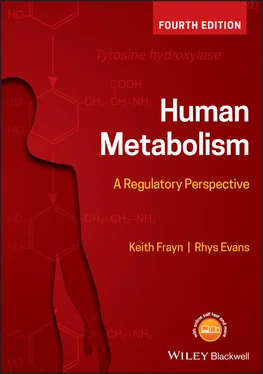12 Chapter 12Figure 12.1 A sufferer from Type 1 diabetes mellitus in the early days of insulin therapy, ...Figure 12.2 Typical plasma glucose and insulin responses to a carbohydrate load in Type 2 d...Figure 12.1.1 Redrawn from Felber, J. -P., Acheson, K. J., & Tappy, L. (1993) From Obesity to...Figure 12.3 The metabolic pattern in untreated Type 1 diabetes. Pathways accelerated by ins...Figure 12.4 Twenty-four-hour profiles of plasma glucose concentration in non-diabetic subje...Figure 12.5 Twenty-four-hour profiles of plasma non-esterified fatty acid (NEFA) concentrat...Figure 12.6 Plasma insulin concentrations in non-diabetic subjects and people with Type 1 d...Figure 12.7 Non-enzymatic glycation of proteins. A sugar molecule in its straight-chain, al...Figure 12.8 The polyol pathway for production and further metabolism of sorbitol. The enzym...
1 Cover
2 Table of Contents
3 Preface
1 C1
2 iii
3 iv
4 vi
5 vii
6 viii
7 ix
8 x
9 xi
10 1
11 2
12 3
13 4
14 5
15 6
16 7
17 8
18 9
19 10
20 11
21 12
22 13
23 14
24 15
25 16
26 17
27 18
28 19
29 20
30 21
31 22
32 23
33 24
34 25
35 26
36 27
37 28
38 29
39 30
40 31
41 32
42 33
43 34
44 35
45 36
46 37
47 38
48 39
49 40
50 41
51 42
52 43
53 44
54 45
55 46
56 47
57 48
58 49
59 50
60 51
61 52
62 53
63 54
64 55
65 56
66 57
67 58
68 59
69 60
70 61
71 62
72 63
73 64
74 65
75 66
76 67
77 68
78 69
79 70
80 71
81 72
82 73
83 74
84 75
85 76
86 77
87 78
88 79
89 80
90 81
91 82
92 83
93 84
94 85
95 86
96 87
97 88
98 89
99 90
100 91
101 92
102 93
103 94
104 95
105 96
106 97
107 98
108 99
109 100
110 101
111 102
112 103
113 104
114 105
115 106
116 107
117 108
118 109
119 110
120 111
121 112
122 113
123 114
124 115
125 116
126 117
127 118
128 119
129 120
130 121
131 122
132 123
133 124
134 125
135 126
136 127
137 128
138 129
139 130
140 131
141 132
142 133
143 134
144 135
145 136
146 137
147 138
148 139
149 140
150 141
151 142
152 143
153 144
154 145
155 146
156 147
157 148
158 149
159 150
160 151
161 152
162 153
163 154
164 155
165 156
166 157
167 158
168 159
169 160
170 161
171 162
172 163
173 164
174 165
175 166
176 167
177 168
178 169
179 170
180 171
181 172
182 173
183 174
184 175
185 176
186 177
187 178
188 179
189 180
190 181
191 182
192 183
193 184
194 185
195 186
196 187
197 188
198 189
199 190
200 191
201 192
202 193
203 194
204 195
205 196
206 197
207 198
208 199
209 200
210 201
211 202
212 203
213 204
214 205
215 206
216 207
217 208
218 209
219 210
220 211
221 212
222 213
223 214
224 215
225 216
226 217
227 218
228 219
229 220
230 221
231 222
232 223
233 224
234 225
235 226
236 227
237 228
238 229
239 230
240 231
241 232
242 233
243 234
244 235
245 236
246 237
247 238
248 239
249 240
250 241
251 242
252 243
253 244
254 245
255 246
256 247
257 248
258 249
259 250
260 251
261 252
262 253
263 254
264 255
265 256
266 257
267 258
268 259
269 260
270 261
271 262
272 263
273 264
274 265
275 266
276 267
277 268
278 269
279 270
280 271
281 272
282 273
283 274
284 275
285 276
286 277
287 278
288 279
289 280
290 281
291 282
292 283
293 284
294 285
295 286
296 287
297 288
298 289
299 290
300 291
301 292
302 293
303 294
304 295
305 296
306 297
307 298
308 299
309 300
310 301
311 302
312 303
313 304
314 305
315 306
316 307
317 308
318 309
319 310
320 311
321 312
322 313
323 314
324 315
325 316
326 317
327 318
328 319
329 320
330 321
331 322
332 323
333 324
334 325
335 326
336 327
337 328
338 329
339 330
340 331
341 332
342 333
343 334
344 335
345 336
346 337
347 338
348 339
349 340
350 341
351 342
352 343
353 344
354 345
355 346
356 346
357 347
358 348
359 349
360 350
361 351
362 352
363 353
364 354
365 355
366 356
367 357
368 358
369 359
370 360
371 361
372 362
373 363
374 364
375 365
376 366
377 367
378 368
379 369
380 370
381 371
382 372
383 373
384 374
385 375
386 376
387 377
388 378
389 379
390 380
391 E1
The first edition of Metabolic Regulation: A Human Perspective appeared in 1996. (It was pink.) When the second edition was published (in green) in 2003, it seemed that a revolution was taking place in metabolism. Tissues that we always thought were ‘doing metabolism’ turned out to be secreting hormones, adipose tissue and leptin being the prime example. By 2010, when the third (blue) edition was published, there were yet more changes in our understanding of metabolism and its regulation. The regulation of gene expression by nutrients (including, for instance, the carbohydrate-response element binding protein) was much better understood than previously. The techniques of genetic manipulation had also increased our understanding of metabolic pathways. In 1996, nobody could have guessed that a mouse without the adipose tissue enzyme hormone-sensitive lipase would be viable, let alone relatively normal: that finding led to the discovery of another enzyme of fat mobilisation, adipose triglyceride lipase. Similar studies made us revise our ideas about other ‘well-established’ enzymes such as phosphoenolpyruvate carboxykinase. Now, in 2018, we see more radical developments in the field. We always thought that hormones were hormones and metabolites were metabolites – now we know that the distinction is far from clear, with many compounds we regard as metabolites signalling through receptors as do ‘true hormones,’ thereby modulating metabolism. (We note in passing that the late Derek Williamson – colleague to both of us, and mentor to one [RDE], would not have been surprised: he had long predicted that the ketone bodies had a signalling role.)
We have always recognised that this textbook needed to be regarded as a complement to a more conventional biochemistry textbook, which would give details of pathways rather than just notes on their regulation. We have both taught metabolism to biochemistry and medical students in Oxford, and for this edition decided to combine our areas of expertise and to add material to the book that would enable it to be used more independently. Thus, in Chapter 1of this new edition, we have provided overviews of metabolic pathways that will then be described in more detail in subsequent chapters. A particular emphasis of the later chapters, as in previous editions, is the tissue-specificity of these metabolic pathways. We are aware that this textbook is used by medical and nursing students and that has prompted us to include more material relevant to metabolism in clinical situations such as cancer, sepsis, and trauma. We hope this material will be of interest to all students, including those of nutrition and sports science, as it illustrates how metabolism may be perturbed. The small revision to the title of the book reflects these changes.
Читать дальше












